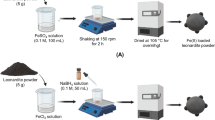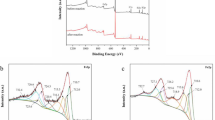Abstract
In the present work, an effort was made for the first time to develop novel catalysts by recycling broken borosilicate glass (BSG) loaded with iron and cobalt for the abatement of methylene blue (MB) and COD from real textile wastewater. In the study, the comparison of adsorption, single ozonation (SO), and catalytic ozonation with both catalysts (Fe-BSG) and (Co-BSG) for the removal of MB was evaluated on various operational parameters such as ozone flow (0.552–1.08 mg/min), reaction time (2–23 min), catalyst dose (1.25–5 g/L), and pH (4–10). Moreover, the prepared catalysts Fe-BSG and Co-BSG were characterized by SEM, FTIR, EDS, and BET. Furthermore, results revealed that the Co-BSG/O3 was more efficient than others and decolorization of MB was found to be 6.2%, 72%, 79%, and 92% at 6.8 pH in 8 min, and removal of COD was 3.5%, 69%, 81%, and 93% at pH 6.8 in 40 min for BSG, SO, Fe-BSG/O3, and Co-BSG/O3, respectively. In the current investigation, the tert-butyl alcohol effect exposed the leading role of hydroxyl radicals during Co-BSG/O3 as the MB efficiency was reduced by 28% in addition of hydroxyl radical scavengers as compared to the SO process. It was found that the catalyst remained stable and efficient after 3 cycles due to the minute quantity of metal leached. Therefore, the studied novel advanced method may significantly be applied on the industrial scale for the abatement of dyes and COD from real textile wastewater.











Similar content being viewed by others
References
Benkhaya, S.; M’rabet, S.; El Harfi, A.: A review on classifications, recent synthesis and applications of textile dyes. Inorg. Chem. Commun. 115, 107891 (2020)
Ramos, M., et al.: A review on the treatment of textile industry effluents through Fenton processes. Process Saf. Environ. Prot. 155, 366–386 (2021)
Saini, R.D.: Textile organic dyes: polluting effects and elimination methods from textile waste water. Int. J. Chem. Eng. Res. 9(1), 121–136 (2017)
Vajnhandl, S.; Valh, J.V.: The status of water reuse in European textile sector. J. Environ. Manag. 141, 29–35 (2014)
Shindhal, T., et al.: A critical review on advances in the practices and perspectives for the treatment of dye industry wastewater. J. Bioeng. 12(1), 70–87 (2021)
Dihom, H.R., et al.: Photocatalytic degradation of disperse azo dyes in textile wastewater using green zinc oxide nanoparticles synthesized in plant extract: a critical review. J. Water Process Eng. 47, 102705 (2022)
Adegoke, K.A.; Bello, O.S.: Dye sequestration using agricultural wastes as adsorbents. Water Resour. Ind. 12, 8–24 (2015)
Lellis, B., et al.: Effects of textile dyes on health and the environment and bioremediation potential of living organisms. Biotechnol. Res. Innov. 3(2), 275–290 (2019)
Njanja, E., et al.: Comparative assessment of methylene blue biosorption using coffee husks and corn cobs: towards the elaboration of a lignocellulosic-based amperometric sensor. SN Appl. Sci. 1(6), 1–14 (2019)
Berradi, M., et al.: Textile finishing dyes and their impact on aquatic environs. Heliyon 5(11), e02711 (2019)
Modi, S., et al.: Recent and emerging trends in remediation of methylene blue dye from wastewater by using zinc oxide nanoparticles. Water 14(11), 1749 (2022)
Gamal El-Shamy, A.: Novel in-situ synthesis of nano-silica (SiO2) embedded into polyvinyl alcohol for dye removal: adsorption and photo-degradation under visible light. Polymer 242, 124579 (2022)
Babar, M., et al.: Comparative study of ozonation and ozonation catalyzed by Fe-loaded biochar as catalyst to remove methylene blue from aqueous solution. Chemosphere 307, 135738 (2022)
Ikhlaq, A., et al.: Comparative study of catalytic ozonation and Fenton-like processes using iron-loaded rice husk ash as catalyst for the removal of methylene blue in wastewater. Ozone Sci. Eng. 41(3), 250–260 (2019)
Aziz, K.H.H., et al.: Application of a planar falling film reactor for decomposition and mineralization of methylene blue in the aqueous media via ozonation, Fenton, photocatalysis and non-thermal plasma: a comparative study. Process Saf. Environ. Prot. 113, 319–329 (2018)
Wu, J.; Upreti, S.R.: Continuous ozonation of methylene blue in water. J. Water Process Eng. 8, 142–150 (2015)
Rizvi, O.S., et al.: Application of poly aluminum chloride and alum as catalyst in catalytic ozonation process after coagulation for the treatment of textile wastewater. J. Environ. Manag. 323, 115977 (2022)
Masood, Z., et al.: Application of nanocatalysts in advanced oxidation processes for wastewater purification: challenges and future prospects. Catalysts 12(7), 741 (2022)
Boukoussa, B.; Mokhtar, A.: Silica-polymer composite for dyes removal. In: Polymer Technology in Dye-Containing Wastewater, pp. 39–55. Springer, New York (2022)
Amin, N.A.S.; Akhtar, J.; Rai, H.: Screening of combined zeolite-ozone system for phenol and COD removal. Chem. Eng. J. 158(3), 520–527 (2010)
Ikhlaqa, A., et al.: Combined UV catalytic ozonation process on iron loaded peanut shell ash for the removal of methylene blue from aqueous solution. Desalin. Water Treat. 200, 231–240 (2020)
Ikhlaq, A., et al.: Removal of methylene blue dye from aqueous solutions by adsorption in combination with ozonation on iron loaded sodium zeolite: role of adsorption. Desalin. Water Treat. 237, 302–306 (2021)
Rice, A.; Baird, E.; Eaton, R.: APHA 2017 Standard Methods for Examination of Water and Wastewater. American Public Health Association, American Water Works Association, and Water Env. Federation ISBN, Washington (2017)
Nariyal, R.; Kothari, P.; Bisht, B.: FTIR measurements of SiO 2 glass prepared by sol-gel technique. Chem. Sci. Trans. 3(3), 1064–1066 (2014)
Dutta Gupta, A., Bhadauria, V., Singh, H.: Silica derived from rice husk ash and loaded with iron oxide for As (III) adsorption from water: experimental and modelling studies. Int. J. Environ. Anal. Chem. 1–24 (2021)
Asab, G., Zereffa, E.A., Abdo Seghne T.: Synthesis of silica-coated Fe3O4 nanoparticles by microemulsion method: characterization and evaluation of antimicrobial activity. Int. J. Biomater. 2020 (2020)
Kababji, A.; Joseph, B.; Wolan, J.: Silica-supported cobalt catalysts for Fischer-Tropsch synthesis: effects of calcination temperature and support surface area on cobalt silicate formation. Catal. Lett. 130(1), 72–78 (2009)
Sotiles, A.R., et al.: Cobalt complexes: introduction and spectra analysis. Orbital Electron. J. Chem. 11(6), 348–354 (2019)
Basturk, E.; Işık, M.; Karatas, M.: Removal of aniline (Methylene Blue) and azo (Reactive Red 198) dyes by photocatalysis via nano TiO2. Desalin. Water Treat. 143, 306–313 (2019)
Asgari, G., et al.: Catalytic ozonation of phenol using copper coated pumice and zeolite as catalysts. J. Res. Health Sci. 12(2), 93–97 (2012)
Ikhlaq, A.; Brown, D.R.; Kasprzyk-Hordern, B.: Mechanisms of catalytic ozonation: an investigation into superoxide ion radical and hydrogen peroxide formation during catalytic ozonation on alumina and zeolites in water. Appl. Catal. B 129, 437–449 (2013)
Adam, F.; Andas, J.; Rahman, I.: The synthesis and characterization of cobalt-rice husk silica nanoparticles. Open Colloid Sci. J. 4, 12–18 (2011)
Hermanek, M., et al.: Catalytic efficiency of iron (III) oxides in decomposition of hydrogen peroxide: competition between the surface area and crystallinity of nanoparticles. J. Am. Chem. Soc. 129(35), 10929–10936 (2007)
Adam, F., Andas J.: The synthesis and characterization of cobalt-rice husk silica nanoparticles. Open Colloid Sci. J. 4(1) (2010)
Chen, J., et al.: Catalytic ozonation performance of Calcium-loaded catalyst (Ca-C/Al2O3) for effective treatment of high salt organic wastewater. Sep. Purif. Technol. 301, 121937 (2022)
Akbarzadeh, O., et al.: Effects of cobalt loading, particle size, and calcination condition on Co/CNT catalyst performance in Fischer-Tropsch reactions. Symmetry 11(1), 7 (2019)
Pervez, M.N., et al.: New sustainable approach for the production of Fe3O4/graphene oxide-activated persulfate system for dye removal in real wastewater. Water 12(3), 733 (2020)
Chen, J., et al.: Metal cobalt embedded N-doped carbon nanotube catalyst for catalytic ozonation. Mater. Lett. 324, 132631 (2022)
Qazi, U.Y., et al.: Application of Fe-RGO for the removal of dyes by catalytic ozonation process. Environ. Sci. Pollut. Res. 1–13 (2022)
Rodríguez López, A.D., et al.: Discoloration on methylene blue solutions by direct and catalytic ozonation. J. Mater. Sci. Chem. Eng. 1(5), 33–38 (2013)
Heebner, A.; Abbassi, B.: Electrolysis catalyzed ozonation for advanced wastewater treatment. J. Water Process Eng. 46, 102638 (2022)
Ikhlaq, A., et al.: Potable water treatment in a batch reactor benefited by combined filtration and catalytic ozonation. Water 14(15), 2357 (2022)
Qazi, U.Y., et al.: Synergistically improved catalytic ozonation process using iron-loaded activated carbons for the removal of arsenic in drinking water. Water 14(15), 2406 (2022)
Li, Z., et al.: Nanosheets-MnxOy anchored biochar for efficient removal of methyl blue and tetracycline from water. Chem. Eng. Res. Des. 182, 13–24 (2022)
Kanan, S., et al.: Recent advances on TiO2-based photocatalysts toward the degradation of pesticides and major organic pollutants from water bodies. Catal. Rev. 62(1), 1–65 (2020)
Li, Y., et al.: Recent advances in waste water treatment through transition metal sulfides-based advanced oxidation processes. Water Res. 192, 116850 (2021)
Alver, A.; Kılıç, A.J.C.: Catalytic ozonation by iron coated pumice for the degradation of natural organic matters. Catalysts 8(5), 219 (2018)
Oputu, O., et al.: Catalytic activities of ultra-small β-FeOOH nanorods in ozonation of 4-chlorophenol. J. Environ. Sci. 35, 83–90 (2015)
Pasquini, C., et al.: Operando tracking of oxidation-state changes by coupling electrochemistry with time-resolved X-ray absorption spectroscopy demonstrated for water oxidation by a cobalt-based catalyst film. Anal. Bioanal. Chem. 413(21), 5395–5408 (2021)
Noh, C.; Chung, Y.; Kwon, Y.: Optimization of iron and cobalt based organometallic redox couples for long-term stable operation of aqueous organometallic redox flow batteries. J. Power Sources 495, 229799 (2021)
Huang, Z.-F., et al.: Hollow cobalt-based bimetallic sulfide polyhedra for efficient all-pH-value electrochemical and photocatalytic hydrogen evolution. J. Am. Chem. Soc. 138(4), 1359–1365 (2016)
Chen, C., et al.: Efficiencies and mechanisms of ZSM5 zeolites loaded with cerium, iron, or manganese oxides for catalytic ozonation of nitrobenzene in water. Sci. Total Environ. 612, 1424–1432 (2018)
Chen, S., et al.: Zero-valent iron-copper bimetallic catalyst supported on graphite from spent lithium-ion battery anodes and mill scale waste for the degradation of 4-chlorophenol in aqueous phase. Separation Purification Technology 286, 120466 (2022)
Zhu, S.-N., et al.: Catalytic ozonation of basic yellow 87 with a reusable catalyst chip. Chem. Eng. J. 242, 180–186 (2014)
Ding, M., et al.: Heterogeneous Fe2CoTi3O10-MXene composite catalysts: synergistic effect of the ternary transition metals in the degradation of 2, 4-dichlorophenoxyacetic acid based on peroxymonosulfate activation. Chem. Eng. J. 378, 122177 (2019)
Kruanak, K.; Jarusutthirak, C.: Degradation of 2, 4, 6-trichlorophenol in synthetic wastewater by catalytic ozonation using alumina supported nickel oxides. J. Environ. Chem. Eng. 7(1), 102825 (2019)
Tang, X., et al.: Mechanism and toxicity evaluation of catalytic ozonation over Cu/Ce–Al2O3 system aiming at degradation of humic acid in real wastewater. Sci. Rep. 11(1), 1–13 (2021)
Meili, L., et al.: MgAl-LDH/Biochar composites for methylene blue removal by adsorption. Appl. Clay Sci. 168, 11–20 (2019)
Shokoohi, R., et al.: Comparing the performance of the peroxymonosulfate/Mn3O4 and three-dimensional electrochemical processes for methylene blue removal from aqueous solutions: kinetic studies. Colloid Interface Sci. Commun. 42, 100394 (2021)
Funding
No funding was received for the present research. However, the authors are thankful to the University of Engineering and Technology, Lahore, Pakistan, for the technical support.
Author information
Authors and Affiliations
Corresponding authors
Ethics declarations
Conflict of interest
The authors declare that they have no known competing financial interests or personal relationships that could have appeared to influence the work reported in this paper.
Rights and permissions
Springer Nature or its licensor (e.g. a society or other partner) holds exclusive rights to this article under a publishing agreement with the author(s) or other rightsholder(s); author self-archiving of the accepted manuscript version of this article is solely governed by the terms of such publishing agreement and applicable law.
About this article
Cite this article
Javed, F., Tariq, A., Ikhlaq, A. et al. Application of Laboratory-Grade Recycled Borosilicate Glass Coated with Iron and Cobalt for the Removal of Methylene Blue by Catalytic Ozonation Process. Arab J Sci Eng 48, 8753–8768 (2023). https://doi.org/10.1007/s13369-022-07437-6
Received:
Accepted:
Published:
Issue Date:
DOI: https://doi.org/10.1007/s13369-022-07437-6




